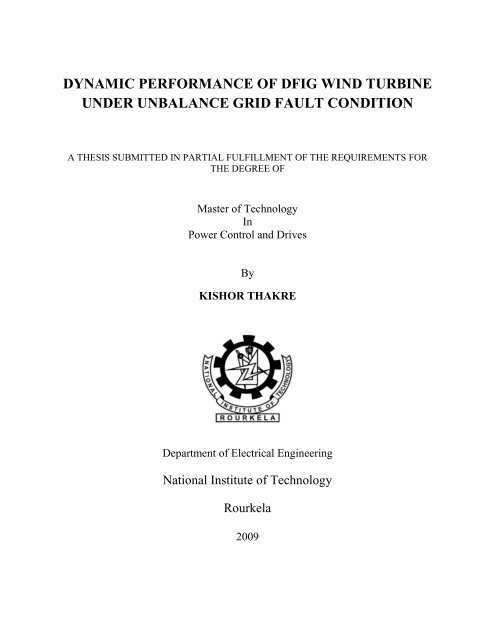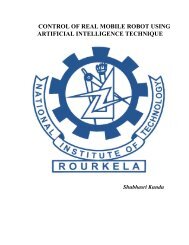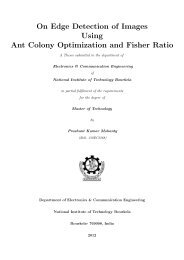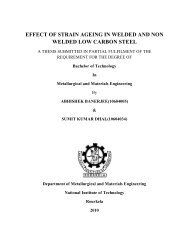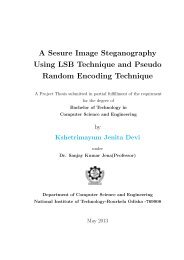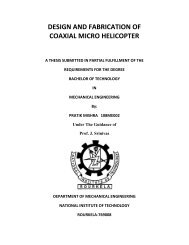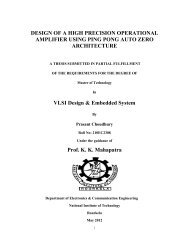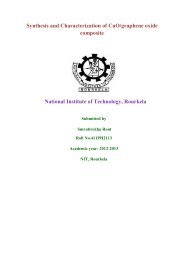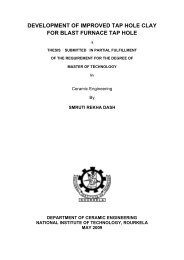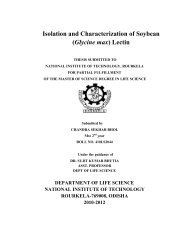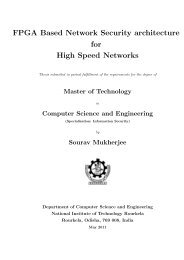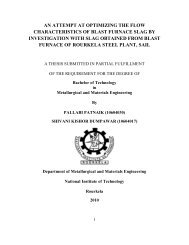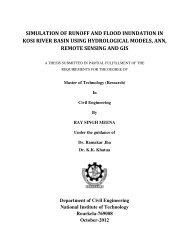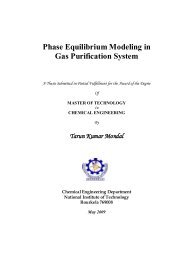dynamic performance of dfig wind turbine under unbalance - ethesis
dynamic performance of dfig wind turbine under unbalance - ethesis
dynamic performance of dfig wind turbine under unbalance - ethesis
You also want an ePaper? Increase the reach of your titles
YUMPU automatically turns print PDFs into web optimized ePapers that Google loves.
DYNAMIC PERFORMANCE OF DFIG WIND TURBINE<br />
UNDER UNBALANCE GRID FAULT CONDITION<br />
A THESIS SUBMITTED IN PARTIAL FULFILLMENT OF THE REQUIREMENTS FOR<br />
THE DEGREE OF<br />
Master <strong>of</strong> Technology<br />
In<br />
Power Control and Drives<br />
By<br />
KISHOR THAKRE<br />
Department <strong>of</strong> Electrical Engineering<br />
National Institute <strong>of</strong> Technology<br />
Rourkela<br />
2009
DYNAMIC PERFORMANCE OF DFIG WIND TURBINE<br />
UNDER UNBALANCE GRID FAULT CONDITION<br />
A THESIS SUBMITTED IN PARTIAL FULFILLMENT OF THE REQUIREMENTS FOR THE<br />
DEGREE OF<br />
Master <strong>of</strong> Technology<br />
In<br />
Power Control and Drives<br />
By<br />
KISHOR THAKRE<br />
Under the Guidance <strong>of</strong><br />
Dr. SHARMILI DAS<br />
Department <strong>of</strong> Electrical Engineering<br />
National Institute <strong>of</strong> Technology<br />
Rourkela<br />
2009
NATIONAL INSTITUTE OF TECHNOLOGY<br />
ROURKELA<br />
CERTIFICATE<br />
This is to certify that the thesis report entitled “Dynamic <strong>performance</strong> <strong>of</strong> DFIG <strong>wind</strong> <strong>turbine</strong><br />
<strong>under</strong> <strong>unbalance</strong> grid fault condition” submitted by Kishor Thakre, has been carried out<br />
<strong>under</strong> my super vision in partial fulfillment <strong>of</strong> the requirements <strong>of</strong> the degree <strong>of</strong> Master <strong>of</strong><br />
Technology with specialization in “Power Control and Drives” during session 2008-2009 in the<br />
Department <strong>of</strong> Electrical Engineering, National Institute <strong>of</strong> Technology, Rourkela (Deemed<br />
University) and this work has not been submitted elsewhere for a degree.<br />
To the best <strong>of</strong> my knowledge, the matter embodied in the thesis has not been submitted to<br />
any other university/institute for the award <strong>of</strong> any degree.<br />
Date: Dr. SHARMILI DAS<br />
Dept. <strong>of</strong> Electrical Engineering<br />
National Institute <strong>of</strong> Technology, Rourkela
ACKNOWLEDGEMENT<br />
On the submission <strong>of</strong> thesis report <strong>of</strong> “Dynamic <strong>performance</strong> <strong>of</strong> DFIG <strong>wind</strong> <strong>turbine</strong><br />
<strong>under</strong> <strong>unbalance</strong> grid fault condition” I would like to extend my gratitude and sincere thanks<br />
to my supervisor Dr. Sharmili Das, for her constant motivation and support during the course <strong>of</strong><br />
my thesis. I truly appreciate and value her esteemed guidance and encouragement from the<br />
beginning to the end <strong>of</strong> this thesis. I am indebted to her for having helped me to shape the<br />
problem and providing insights towards the solution.<br />
I express my gratitude to Dr. B.D. Subudhi, Pr<strong>of</strong>essor and Head <strong>of</strong> the Department, Electrical<br />
Engineering for his valuable suggestions and constant encouragement all through the thesis<br />
work.<br />
My special thanks to all my friends who did their thesis computational work in<br />
Simulation & Computing Lab, Electrical Engineering, and providing me good company in the<br />
lab. Also I would like to thank all those who have directly and indirectly supported and helped<br />
me towards the completion <strong>of</strong> my thesis.<br />
I wish to express my gratitude to my parents, whose love and encouragement have a great<br />
support throughout my education.<br />
Kishor Thakre<br />
Roll- No. - 207EE212
CONTENTS<br />
TITLE Page No.<br />
AKNOWLEDGEMENT<br />
ABSTRACT i<br />
LIST OF FIGURES ii<br />
NOMENCLATURE iv<br />
Chapter 1. INTRODUCTION 1<br />
1.1 Introduction 2<br />
1.2 Literature survey 8<br />
1.3 Motivation 9<br />
1.4 Objectives an thesis outline 10<br />
Chapter 2. INDUCTION MACHINE 11<br />
2.1 Introduction 12<br />
2.2 Dynamic d-q model 13<br />
2.2.1 Axes transformation 13<br />
2.2.2 Synchronously rotating reference frame-Dynamic model. 16<br />
2.3 Induction machine control 18<br />
2.3.1 Scalar control 19<br />
2.3.2 Vector control or field oriented control 19<br />
2.4 DC drive Analogy 20<br />
2.5 Principle <strong>of</strong> vector control 22<br />
Chapter 3. WIND TURBINE AND DOUBLE FED INDUCTION GENERATOR 24<br />
3.1 Wind <strong>turbine</strong> 25
3.2 System configuration <strong>of</strong> a variable speed DFIG <strong>wind</strong> <strong>turbine</strong> 25<br />
3.2.1 Wind <strong>turbine</strong> modeling 28<br />
3.3 Double fed induction generator 31<br />
3.3.1 Modeling <strong>of</strong> DFIG 34<br />
3.3.2 DFIG simulink model 36<br />
3.4 DFIG driven by DC motor 37<br />
Chapter 4. DYNAMIC RESPONSE OF DFIG UNDER UNBALANCE CONDITION 38<br />
4.1ntroduction 39<br />
4.2 double fed induction machine <strong>under</strong> fault 39<br />
4.2.1 Behavior immediately after the fault 40<br />
4.2.2 Behavior at Fault Clearance 41<br />
Chapter 5. SIMULATION RESULTS AND DISCUSSION 42<br />
5.1 Free acceleration characteristics 43<br />
5.2 Wind <strong>turbine</strong> DFIG with normal condition 45<br />
5.3 Wind <strong>turbine</strong> DFIG during grid fault condition 49<br />
5.4 <strong>wind</strong> <strong>turbine</strong> DFIG during <strong>unbalance</strong> condition 54<br />
5.5 DC machine coupled with DFIG during grid fault 63<br />
5.6 DC machine coupled with DFIG during <strong>unbalance</strong> grid condition 67<br />
Chapter 6. CONCLUSION 71<br />
APPENDIX 73<br />
REFERENCES 74
Dedicated to<br />
my<br />
Late brother
ABSTRACT<br />
The global electrical energy consumption is rising and there is steady increase <strong>of</strong> the<br />
demand on power generation. So in addition to conventional power generation units a large no.<br />
<strong>of</strong> renewable energy units is being integrated into the power system. A <strong>wind</strong> electrical<br />
generation system is the most cost competitive <strong>of</strong> all the environmentally clean and safe<br />
renewable energy sources in world. The recent evolution <strong>of</strong> power semiconductors and variable<br />
frequency drive technology has aided the acceptance <strong>of</strong> variable speed generation systems.<br />
Both fixed-speed squirrel-cage induction generator and variable speed double fed<br />
induction generator are used in <strong>wind</strong> <strong>turbine</strong> generation technology. Therefore, a detailed model<br />
<strong>of</strong> induction generator coupled to <strong>wind</strong> <strong>turbine</strong> system is presented in the thesis. Modeling and<br />
simulation <strong>of</strong> induction machine using vector control computing technique is done in<br />
MATLAB/SIMULINK platform. The significant result <strong>of</strong> the analysis is also shown and being<br />
compared with the existing literature to validate approach.<br />
DFIG–<strong>wind</strong> <strong>turbine</strong> is an integrated part <strong>of</strong> distributed generation system. Therefore, any<br />
abnormalities associates with grid are going to affect the system <strong>performance</strong> considerably.<br />
Taking this into account, the <strong>performance</strong> <strong>of</strong> double fed induction generator (DFIG) variable<br />
speed <strong>wind</strong> <strong>turbine</strong> <strong>under</strong> network fault is studied using simulation developed in<br />
MATLAB/SIMULINK results show the transient behavior <strong>of</strong> the double fed induction generator<br />
when a sudden short circuit at the generator. After the clearance the short circuit fault the control<br />
schemes manage to restore the <strong>wind</strong> <strong>turbine</strong>’s normal operation. The controller <strong>performance</strong> is<br />
demonstrated by simulation result both during fault and the clearance <strong>of</strong> the fault. A crowbar is<br />
used to protect the rotor converter against short-circuit current during faults.<br />
i
LIST OF FIGURES<br />
Fig. 2.1 Stationary frame a-b-c to - axes transformation 15<br />
Fig. 2.2 Stationary frame - to synchronous rotating frame - 16<br />
Fig. 2.3 Dynamic axis circuit 17<br />
Fig. 2.4 Dynamic axis circuit 17<br />
Fig. 2.5 Separately exited DC motor 20<br />
Fig. 2.6 vector control induction motor 21<br />
Fig. 2.7 Vector control implementation principle with machine ( − ) model 23<br />
Fig.3.1 Pitch angle control 26<br />
Fig. 3.2 Variable speed <strong>wind</strong> <strong>turbine</strong>s: 27<br />
(a) With full-size converter<br />
(b) With doubly-fed induction generator<br />
Fig. 3.3 Damping controller 28<br />
Fig. 3.4 Simulink model <strong>of</strong> <strong>wind</strong> <strong>turbine</strong> 30<br />
Fig.3.5 Double fed induction machine 31<br />
Fig.3.6 DFIG rotor side controller 33<br />
Fig. 3.7 Simulink model <strong>of</strong> rotor side controller 33<br />
Fig. 3.8 detailed model in simulink <strong>of</strong> DFIG 36<br />
Fig. 3.9 Simulink model <strong>of</strong> DFIG with DC motor with three phase fault 37<br />
Fig. 4.1 block diagram <strong>of</strong> DFIG with fault in grid side 40<br />
Fig. 5.1.1 free acceleration characteristics <strong>of</strong> current component ( ) 43<br />
Fig. 5.1.2 speed- torque characteristics 44<br />
Wind <strong>turbine</strong> DFIG <strong>under</strong> normal condition<br />
Fig .5.2.1 stator currents ( ) during balance condition 45<br />
Fig. 5.2.2 rotor currents ( ) during balance condition 46<br />
Fig. 5.2.3 speed and torque ) during balance condition 47<br />
Fig. 5.3.4 active power (P) and reactive power (Q) during balance condition 48<br />
Wind <strong>turbine</strong> DFIG <strong>under</strong> fault condition<br />
ii<br />
Page No.
Fig. 5.3.1 stator voltages during fault condition 49<br />
Fig .5.3.2 stator currents ( ) during fault condition 50<br />
Fig. 5.3.3 rotor currents ( ) during fault condition 51<br />
Fig. 5.3.4 speed and torque ) during fault condition 52<br />
Fig. 5.3.5 active power (P) and reactive power (Q) during fault condition 53<br />
Wind <strong>turbine</strong> DFIG <strong>under</strong> <strong>unbalance</strong> condition<br />
Fig .5.4.1 stator currents ( ) during <strong>dynamic</strong> loading 54<br />
Fig. 5.4.2 rotor currents ( ) during <strong>dynamic</strong> loading 55<br />
Fig. 5.4.3 speed and torque ) during <strong>dynamic</strong> loading 56<br />
Fig. 5.4.4 active power (P) and reactive power (Q) during <strong>dynamic</strong> loading 57<br />
Fig. 5.4.5 stator voltages during voltage dip 58<br />
Fig .5.4.6 stator currents ( ) during voltage dip 59<br />
Fig. 5.4.7 rotor currents ( ) during voltage dip 60<br />
Fig. 5.4.8 speed and torque ) during voltage dip 61<br />
Fig.5.4.9 active power (P) and reactive power (Q) during voltage dip 62<br />
DC machine coupled with DFIG during fault condition<br />
Fig .5.5.1 stator currents ( ) during fault condition 63<br />
Fig. 5.5.2 rotor currents ( ) during fault condition 64<br />
Fig. 5.5.3 speed and torque ) during fault condition 65<br />
Fig.5.5.4 active power (P) and reactive power (Q) during fault condition 66<br />
DC machine coupled with DFIG <strong>under</strong> <strong>unbalance</strong> condition<br />
Fig .5.6.1 stator currents ( ) during <strong>unbalance</strong> condition 67<br />
Fig. 5.6.2 rotor currents ( ) during <strong>unbalance</strong> condition 68<br />
Fig. 5.6.3 Speed and torque ) during <strong>unbalance</strong> condition 69<br />
Fig.5.6.4 active power (P) and reactive power (Q) during <strong>unbalance</strong> condition 70<br />
iii
NOMENCLATURE<br />
, Stator d and q <strong>wind</strong>ing voltage.<br />
, Stator d and q <strong>wind</strong>ing current.<br />
, Rotor d and q <strong>wind</strong>ing voltage.<br />
, Rotor d and q <strong>wind</strong>ing current.<br />
<br />
Stator d and q <strong>wind</strong>ing flux linkage.<br />
, <br />
Rotor d and q <strong>wind</strong>ing flux linkage<br />
Electromagnetic torque.<br />
Mechanical torque<br />
Stator reactive power.<br />
Stator active power<br />
Generator magnetizing inductance.<br />
, Stator and rotor per phase <strong>wind</strong>ing inductance.<br />
, Stator and rotor per phase leakage inductance.<br />
, Stator and rotor per phase <strong>wind</strong>ing resistance.<br />
p Number <strong>of</strong> generator poles.<br />
H System moment <strong>of</strong> inertia.<br />
B System frictional constant.<br />
ω Synchronous rotational speed (50 Hz).<br />
Rotor mechanical speed.<br />
Base speed<br />
iv
1<br />
CHAPTER 1<br />
INTRODUCTION<br />
Introduction<br />
Literature Survey<br />
Motivation<br />
Objective and thesis outline
1.1 INTRODUCTION<br />
Wind energy generation equipment is most <strong>of</strong>ten installed in remote, rural areas. These<br />
remote areas usually have weak grids, <strong>of</strong>ten with voltage <strong>unbalance</strong>s and <strong>under</strong> voltage<br />
conditions. When the stator phase voltages supplied by the grid are <strong>unbalance</strong>d, the torque<br />
produced by the induction generator is not constant. Instead, the torque has periodic pulsations at<br />
twice the grid frequency, which can result in acoustic noise at low levels and at high levels can<br />
damage the rotor shaft, gearbox, or blade assembly. Also an induction generator connected to an<br />
<strong>unbalance</strong>d grid will draw <strong>unbalance</strong>d current. These <strong>unbalance</strong>d current tend to magnify the<br />
grid voltage <strong>unbalance</strong> and cause over current problems as well.<br />
Wind energy has been the subject <strong>of</strong> much recent research and development. In order to<br />
overcome the problems associated with fixed speed <strong>wind</strong> <strong>turbine</strong> system and to maximize the<br />
<strong>wind</strong> energy capture, many new <strong>wind</strong> farms will employ variable speed <strong>wind</strong> <strong>turbine</strong>. DFIG<br />
(Double Fed Induction Generator) is one <strong>of</strong> the component <strong>of</strong> Variable speed <strong>wind</strong> <strong>turbine</strong><br />
system. DFIG <strong>of</strong>fers several advantages when compared with fixed speed generators including<br />
speed control. These merits are primarily achieved via control <strong>of</strong> the rotor side converter. Many<br />
works have been proposed for studying the behavior <strong>of</strong> DFIG based <strong>wind</strong> <strong>turbine</strong> system<br />
connected to the grid. Most existing models widely use vector control Double Fed Induction<br />
Generator. The stator is directly connected to the grid and the rotor is fed to magnetize the<br />
machine.<br />
Wind electrical power system are recently getting lot <strong>of</strong> attention, because they are cost<br />
competitive, environmental clean and safe renewable power sources, as compared fossil fuel and<br />
nuclear power generation.<br />
The reason for the world wide interest in developing <strong>wind</strong> generation plants is the rapidly<br />
increasing demand for electrical energy and the consequent depletion reserves <strong>of</strong> fossil fuels,<br />
namely, oil and coal. Many places also do not have the potential for generating hydel power.<br />
Nuclear power generation was once treated with great optimism, but with the knowledge <strong>of</strong> the<br />
environmental hazard with the possible leakage from nuclear power plants, most countries have<br />
decided not to install them anymore.<br />
2
The growing awareness <strong>of</strong> these problems led to heightened research efforts for<br />
developing alternative <strong>of</strong> energy sources for generation <strong>of</strong> electricity. The most desirable source<br />
would be one that non-pollutant, available in abundance and renewable and can be harnessed at<br />
an acceptable cost in both large-scale and small scale system. The most promising source<br />
satisfying all these requirement is <strong>wind</strong>, a natural source energy source.<br />
The development <strong>of</strong> <strong>wind</strong> energy for electrical power generation got a boost when, in the<br />
early decades <strong>of</strong> the twentieth century, aviation technology resulted in an improved<br />
<strong>under</strong>standing <strong>of</strong> the forces acting on the blades moving through air. This resulted in the<br />
development <strong>of</strong> <strong>wind</strong> <strong>turbine</strong> with two or three blades. High speed and high efficiency <strong>of</strong><br />
<strong>turbine</strong>s were the condition for successful electricity generation. Through the efforts <strong>of</strong> countless<br />
scientists and engineer from various disciplines, <strong>wind</strong> energy has now matured as an<br />
economically viable renewable source <strong>of</strong> energy.<br />
Wind energy is one <strong>of</strong> the most available and exploitable forms <strong>of</strong> renewable energy.<br />
Wind blows from a region <strong>of</strong> higher atmospheric pressure to one <strong>of</strong> the lower atmospheric<br />
pressure. The difference in pressure is caused by (A) the fact that earth‟s surface is not uniformly<br />
heated by the sun and (B) the earth‟s rotation. Wind energy is the by product <strong>of</strong> solar energy,<br />
available in the form <strong>of</strong> the kinetics energy <strong>of</strong> air. Wind has been known to man as a natural<br />
source <strong>of</strong> mechanical power for long. The technology <strong>of</strong> <strong>wind</strong> power has evolved over this long<br />
period. Of the various renewable energy sources, <strong>wind</strong> energy has emerged as the most viable<br />
source <strong>of</strong> electrical power and is economically competitive with conventional sources.<br />
The global electrical energy is rising and there is a steady rise <strong>of</strong> the demand on power<br />
generation, transmission, distribution and utilization. The maximum extractable energy from the<br />
0-100m layer <strong>of</strong> air has been estimated to be the order <strong>of</strong> 10 12 KWh/annum, which is <strong>of</strong> the same<br />
order as hydroelectric potential.<br />
The terms “<strong>wind</strong> energy” or “<strong>wind</strong> power” describe the process by which the <strong>wind</strong> is<br />
used to generate mechanical power or electricity. Wind <strong>turbine</strong>s convert the kinetic energy in the<br />
<strong>wind</strong> into mechanical power. This mechanical power can be used for specific tasks (such as<br />
grinding gain or pumping water) or a generator can convert this mechanical power into<br />
electricity.<br />
3
Since earliest recorded history, <strong>wind</strong> power has been used to move ships, grind grain and<br />
pump water. This is the evidence that <strong>wind</strong> energy was used to propel boats along the Nile River<br />
as early 5000 B.C. within several centuries before Christ, simple <strong>wind</strong>mills were used in china to<br />
pump water.<br />
In the United States, millions <strong>of</strong> <strong>wind</strong>mills were erected as the American West was<br />
developed during the late 19 th century. Most <strong>of</strong> them were used to pump water for farms and<br />
ranches. By 1900, small electric <strong>wind</strong> systems were developed to generate current, but most <strong>of</strong><br />
these units fail into disuse as inexpensive grid power was extended to rural areas during the<br />
1930s. By 1910, <strong>wind</strong> <strong>turbine</strong> generators were producing electricity in many European<br />
countries.<br />
Wind <strong>turbine</strong>s are available in a variety <strong>of</strong> size, and therefore power ratings. The largest<br />
machine, such as the one built in Hawaii, has propellers that span the more than the length <strong>of</strong> a<br />
football field and stands 20 building stories high, and produces enough electricity to power 1400<br />
homes. A small home-sized <strong>wind</strong> machine has rotors between 8 and 25 feet in diameter and<br />
stands upwards <strong>of</strong> 30 feet and can supply the power needs <strong>of</strong> an all-electric home or small<br />
business.<br />
All electric-generating <strong>wind</strong> <strong>turbine</strong>s, no matter what size, are comprised <strong>of</strong> a few basic<br />
components: the (the part that actually rotates in the <strong>wind</strong>), the electrical generator, a speed<br />
control system, and a tower. Some <strong>wind</strong> machine have fail- safe shutdown system so that if part<br />
<strong>of</strong> the machine fails, the shutdown system turn the blades out <strong>of</strong> the <strong>wind</strong> or puts brakes.<br />
Just like solar electric system, <strong>wind</strong> powered system can be used in two ways: <strong>of</strong>f-grid<br />
or on-grid is when your home or business is entirely disconnected from electric utility company<br />
and you generate absolutely all <strong>of</strong> the electricity you need. Usually these systems cost about 30%<br />
more than an on-grid (or „grid-tie system). A grid tie <strong>wind</strong> power system sends all <strong>of</strong> its<br />
electricity back into the public electrical network (grid) which the electric company gives you<br />
credits for. At the month, the electric company sums up your credits with how much your home<br />
or consumed, and if you‟re lucky the electric company will owe you money! Most electric<br />
companies only pay you a small fraction <strong>of</strong> what they change you for those kilowatt-you‟ve<br />
4
created. So it‟s usually ideal to design a system that very closely <strong>of</strong>fsets how much electricity<br />
you consume or just little less, than attempting to make money from the electric company.<br />
Benefits <strong>of</strong> <strong>wind</strong> power:<br />
A <strong>wind</strong> energy system can provide a cushion against electric power price increases.<br />
Wind energy systems help reduces U.S. dependence on fossil fuels; and they are nonpolluting. If<br />
you live in a remote location, a small <strong>wind</strong> energy system could help you avoid the high costs <strong>of</strong><br />
having utility power lines extended to your site. Although <strong>wind</strong> energy system involves a<br />
significant initial investment, they can be competitive with conventional energy sources when<br />
you account for a lifetime <strong>of</strong> reduced or altogether avoided utility costs. The length <strong>of</strong> the<br />
payback period – the time before the savings resulting from your system equal the cost <strong>of</strong> the<br />
system itself- depends on the system you choose the <strong>wind</strong> resource on your site, electricity costs<br />
in your area, and how you use your <strong>wind</strong> system.<br />
Small <strong>wind</strong> energy systems can be used in connection with an electricity transmission<br />
and distribution system (called grid-connected systems), or in stand-alone application that are not<br />
connected to the utility grid. A grid-connected <strong>wind</strong> <strong>turbine</strong> can reduce consumption <strong>of</strong> utility-<br />
supplied electricity for lighting, appliances, and electric heat. If the <strong>turbine</strong> cannot deliver the<br />
amount <strong>of</strong> energy you need, the utility makes up the difference. When the <strong>wind</strong> system produces<br />
more electricity than the household requires, the excess can be returned to the grid. With the<br />
interconnection available today, switching takes place automatically. Stand-alone <strong>wind</strong> energy<br />
systems can be appropriate for homes, farms, or even entire communities (a co-housing project,<br />
for example) that are far from the nearest utility lines.<br />
Either type <strong>of</strong> the system can be practical if the following condition exist<br />
These are the few requirements <strong>of</strong> <strong>wind</strong> generation system:<br />
Wind generation is dependent on the quality and quantity <strong>of</strong> the <strong>wind</strong> hitting the<br />
blades. The better the <strong>wind</strong> you have the more power you will generate.<br />
The power available in <strong>wind</strong> increases by the cube <strong>of</strong> the <strong>wind</strong> speed – if <strong>wind</strong> speed<br />
doubles, power output increases by eight.<br />
5
Turbulent <strong>wind</strong> (from obstruction, geographical features, etc.) will reduce the power<br />
output as the <strong>turbine</strong> swings back and forth hunting for the <strong>wind</strong>.<br />
These are the few requirements <strong>of</strong> site for <strong>wind</strong> generation system:<br />
The higher a <strong>turbine</strong>, the more power is generated, the better quality the <strong>wind</strong>.<br />
A <strong>wind</strong> <strong>turbine</strong> should be at least 40 ft above any object within a 400 ft radius. Note<br />
there is <strong>of</strong>ten exception to this rule depending on your site.<br />
It is <strong>of</strong>ten more economical to install a higher tower than purchasing a larger <strong>turbine</strong>.<br />
Space: generally locations with an acre or more will be suitable. Most urban location<br />
will not permit you to install a <strong>wind</strong> generator in your yard. A guyed tower requires ½<br />
the height <strong>of</strong> the tower as a radius at a minimum for location <strong>of</strong> anchor points. Space<br />
is also required for ground assembly and erection <strong>of</strong> the tower. Lattice towers require<br />
less surface area, but are more complex and expensive to install.<br />
A special type <strong>of</strong> induction generator, called a doubly fed induction generator (DFIG), is<br />
used extensively for high-power <strong>wind</strong> applications (Fig. 3.4). DFIG‟s ability to control rotor<br />
currents allows for reactive power control and variable speed operation, so it can operate at<br />
maximum efficiency over a wide range <strong>of</strong> <strong>wind</strong> speeds. The Doubly-Fed Induction Generator<br />
(DFIG) is widely used for variable-speed generation, and it is one <strong>of</strong> the most important<br />
generators for Wind Energy Conversion Systems (WECS). Both grid connected and stand-alone<br />
operation is feasible. For variable speed operation, the standard power electronics interface<br />
consists <strong>of</strong> a rotor and stator side PWM inverters that are connected back-to-back. These<br />
inverters are rated, for restricted speed range operation, to a fraction <strong>of</strong> the machine rated power.<br />
Applying vector control techniques yields current control with high <strong>dynamic</strong> response. In grid-<br />
connected applications, the DFIG may be installed in remote, rural areas where weak grids with<br />
<strong>unbalance</strong>d voltages are not uncommon. As reported in induction machines are particularly<br />
sensitive to <strong>unbalance</strong>d operation since localized heating can occur in the stator and the lifetime<br />
<strong>of</strong> the machine can be severely affected. Furthermore, negative-sequence currents in the machine<br />
produce pulsations in the electrical torque, increasing the acoustic noise and reducing the life<br />
span <strong>of</strong> the gearbox, blade assembly and other components <strong>of</strong> a typical WECS. To protect the<br />
machine, in some applications, DFIGs are disconnected from the grid when the phase-to-phase<br />
voltage <strong>unbalance</strong> is above 6%.<br />
6
Controller design parameters for the operation <strong>of</strong> induction generators in <strong>unbalance</strong>d grids<br />
have been reported in, where it is proposed to inject compensating current in the DFIG rotor to<br />
eliminate or reduce torque pulsations. The main disadvantage <strong>of</strong> this method is that the stator<br />
current <strong>unbalance</strong> is not eliminated. Therefore, even when the torque pulsations are reduced, the<br />
induction machine power output is rerated, because the machine current limit is reached by only<br />
one <strong>of</strong> the stator phase. Compensation <strong>of</strong> <strong>unbalance</strong>d voltages and currents in power systems are<br />
addressed in where a STATCOM is used to compensate voltage <strong>unbalance</strong>s. However, the<br />
application <strong>of</strong> the control method to DFIGs is not discussed. No formal methodology for the<br />
design <strong>of</strong> the control systems is presented and only simulation results are discussed in. In this<br />
thesis, a controller design is specified, which compensates the stator current <strong>unbalance</strong> in grid-<br />
connected and stand-alone DFIG operation. The strategy uses two revolving axes theory<br />
(rotating synchronously at ± to obtain the d–q components <strong>of</strong> the negative and positive-<br />
sequence currents in the stator and grid/load. The <strong>unbalance</strong> is compensated by the rotor side<br />
converter. The positive-sequence current is conventionally controlled to regulate the dc link<br />
voltage, whereas negative-sequence current is regulated to reduce or eliminate the grid voltage<br />
<strong>unbalance</strong>. This work also includes some methods like:<br />
The modeling <strong>of</strong> a DFIG for <strong>unbalance</strong>d operation is presented. This model can be used<br />
to study the effects <strong>of</strong> negative-sequence components in the machine, e.g. torque<br />
pulsations in the electrical torque, ripple in the machine flux, etc., The modeling<br />
presented in Section 3 is suitable for analyzing DFIGs feeding <strong>unbalance</strong>d loads as well<br />
as DFIGs connected to <strong>unbalance</strong>d, weak grids.<br />
The control systems, based on two synchronously rotating axes, are presented and fully<br />
analyzed.<br />
The control systems, suitable for compensating the effects <strong>of</strong> negative-sequence<br />
components in a DFIG connected to an <strong>unbalance</strong>d grid are discussed. Grid-connected<br />
operation is considered as the most important application <strong>of</strong> DFIG.<br />
7
1.2 LITERATURE SURVEY<br />
In [1] the DFIG control strategy that enhances the standard speed and reactive power control<br />
with controllers that can compensate for the problems caused by an <strong>unbalance</strong>d grid by balancing<br />
the stator currents and eliminating torque and reactive power pulsations.<br />
[2] Describe the controller to be controlled in positive and negative sequence independently. In<br />
order to implement the separated positive and negative sequence controllers <strong>of</strong> DFIG, two<br />
methods to separate positive and negative sequence in real time are compared.<br />
[3] Presents a centralized supervision <strong>of</strong> the reactive power control for a <strong>wind</strong> farm. A weighting<br />
distribution strategy has been used in order to determine the reactive power reference for each<br />
<strong>wind</strong> generator.<br />
[4] Explain a novel control strategy to overcome these problems; furthermore, it reduces the<br />
rotor voltage, improving the control <strong>of</strong> the rotor current and it accelerates the dumping <strong>of</strong> the<br />
flux oscillations.<br />
[5] Explain a new methodology to compensate the stator voltage <strong>unbalance</strong> <strong>of</strong> DFIG has been<br />
proposed. The effects <strong>of</strong> voltage <strong>unbalance</strong>s in DFIG have been discussed, equivalent circuits<br />
and small-signal models, appropriate to design the current control loops, have been proposed.<br />
Experimental results have been presented to validate the proposed control methodology. For<br />
stand-alone and grid-connected applications the <strong>performance</strong> <strong>of</strong> the control system has been<br />
tested considering variable-speed operation, fixed-speed operation and step connection <strong>of</strong><br />
<strong>unbalance</strong>d loads.<br />
[6] A technique is described which the objective to keep the generator has connected to the grid<br />
in case <strong>of</strong> a grid failure so that it can resume power generation after clearance <strong>of</strong> the fault in the<br />
grid. The key <strong>of</strong> the technique is to limit the high currents and to provide a bypass for it in the<br />
rotor circuit via a set <strong>of</strong> resistors that are connected to the rotor <strong>wind</strong>ings without disconnecting<br />
8
the converter from the rotor or from the grid. The <strong>wind</strong> <strong>turbine</strong> can resume normal operation<br />
within a few hundred milliseconds after the fault has been cleared.<br />
[7] Describe the two alternative fault detection methods, namely the Absolute Normalized DC<br />
Current Method and the Sampling Point Comparison Method. The former method provides<br />
similar fault detection capability while requiring less computational time than the Modified<br />
Normalized DC Current Method.<br />
[8] Describes the <strong>dynamic</strong> behavior <strong>of</strong> a typical fixed speed <strong>wind</strong> <strong>turbine</strong> connected to the grid;<br />
the model is developed in the simulation tool MATLAB/SIMULINK and created as a modular<br />
structure. The pitch control system is used for stabilization <strong>of</strong> the <strong>wind</strong> <strong>turbine</strong> at grid faults. In<br />
this way, voltage stability <strong>of</strong> the system with grid-connected <strong>wind</strong> <strong>turbine</strong>s can be improved by<br />
using blade angle control for a temporary reduction <strong>of</strong> the <strong>wind</strong> <strong>turbine</strong> power during a short-<br />
circuit fault in the grid<br />
1.3 MOTIVATION<br />
Wind is intermittent<br />
Limits <strong>wind</strong>‟s percentage <strong>of</strong> the energy mix.<br />
Wind energy is <strong>of</strong>ten located in rural areas.<br />
Rural grids are <strong>of</strong>ten weak and unstable, and prone to voltage sags, faults, and<br />
<strong>unbalance</strong>s.<br />
Unbalanced grid voltages cause many problems for induction generators<br />
Torque pulsations<br />
Reactive power pulsations<br />
Unbalanced currents<br />
Wind energy is <strong>of</strong>ten installed in rural, remote areas characterized by weak, <strong>unbalance</strong>d<br />
power transmission grids. In induction <strong>wind</strong> generators, <strong>unbalance</strong>d three-phase stator<br />
voltages cause a number <strong>of</strong> problems, such as over current, <strong>unbalance</strong>d currents, reactive<br />
9
power pulsations, and stress on the mechanical components from torque pulsations.<br />
Therefore, beyond a certain amount <strong>of</strong> <strong>unbalance</strong>, induction <strong>wind</strong> generators are switched<br />
out <strong>of</strong> the network. This can further weaken the grid. In doubly fed induction generators<br />
(DFIGs), control <strong>of</strong> the rotor currents allows for adjustable speed operation and reactive<br />
power control<br />
1.4 OBJECTIVE AND THESIS OUTLINE<br />
Objectives<br />
Doubly-fed induction generators are the machines <strong>of</strong> choice for large <strong>wind</strong> <strong>turbine</strong>s in<br />
<strong>wind</strong> power generation.<br />
The objective is to develop a control methodology for a DFIG that can achieve:<br />
Observe the <strong>performance</strong> <strong>of</strong> double fed induction generator during balance and <strong>unbalance</strong><br />
condition.<br />
Thesis outline<br />
Variable speed and reactive power control<br />
Compensation <strong>of</strong> problems caused by an <strong>unbalance</strong>d grid<br />
Reduce torque pulsations<br />
Reduce reactive power pulsations<br />
Balance stator currents<br />
Chapter -2 deals with induction machine with basic <strong>dynamic</strong> d-q model, axes transformation and<br />
also describe dc drive analogy and vector control <strong>of</strong> induction machine in brief.<br />
Chapter-3 deals with modeling <strong>of</strong> <strong>wind</strong> <strong>turbine</strong>, rotor side controller, double fed induction<br />
generator and also deals with detail modeling <strong>of</strong> <strong>wind</strong> <strong>turbine</strong> coupled with DFIG. Detail<br />
modeling <strong>of</strong> DFIG with dc motor drive has been discussed in brief.<br />
Chapter-4 deals with DFIG <strong>under</strong> faults.<br />
Chapter-5 deals with simulation results in balance and <strong>unbalance</strong> conditions.<br />
10
11<br />
CHAPTER 2<br />
INDUCTION MACHINE<br />
Introduction<br />
Dynamic d-q model<br />
Induction machine control<br />
DC drive analogy<br />
Principle <strong>of</strong> vector control
2.1 INTRODUCTION<br />
Variable speed ac drives have been used in the past to perform relatively undemanding<br />
roles in application which preclude the use <strong>of</strong> dc motors, either because <strong>of</strong> the working<br />
environment limits. Because <strong>of</strong> the high cost efficient, fast switching frequency static inverter.<br />
The lower cost <strong>of</strong> ac motors has also been a decisive economic factor in multi motor systems.<br />
However as a result <strong>of</strong> the progress in the field <strong>of</strong> power electronics, the continuing trend is<br />
towards cheaper and more effective power converters, and a single motor ac drives complete<br />
favorably on a purely economic basis with a dc drives.<br />
Among the various ac drive systems, those which contain the cage induction motor have<br />
a particular cost advantage. The cage motor is simple and rugged and is one <strong>of</strong> the cheapest<br />
machines available at all power ratings. Owing to their excellent control capabilities, the variable<br />
speed drives incorporating ac motors and employing modern static converters and torque control<br />
can well complete with high <strong>performance</strong> four quadrant dc drives.<br />
The Induction motors (IM) for many years have been regarded as the workhorse in<br />
industry. Recently, the induction motors were evolved from being a constant speed motors to a<br />
variable speed. In addition, the most famous method for controlling induction motor is by<br />
varying the stator voltage or frequency. To use this method, the ratio <strong>of</strong> the motor voltage and<br />
frequency should be approximately constant. With the invention <strong>of</strong> Field Orientated Control, the<br />
complex induction motor can be modeled as a DC motor by performing simple transformations.<br />
In a similar manner to a dc machine, in induction motor the armature <strong>wind</strong>ing is also on the<br />
rotor, while the field is generated by currents in the stator <strong>wind</strong>ing. However the rotor current is<br />
not directly derived from an external source but results from the emf induced in the <strong>wind</strong>ing as a<br />
result <strong>of</strong> the relative motion <strong>of</strong> the rotor conductors with respect to the stator field. In other<br />
words, the stator current is the source <strong>of</strong> both the magnetic field and armature current. In the<br />
most commonly used, squirrel cage motor, only the stator current can directly be controlled,<br />
since the rotor <strong>wind</strong>ing is not accessible. Optimal torque production condition are not inherent<br />
due to the absence <strong>of</strong> a fixed physical disposition between the stator and rotor fields, and the<br />
torque equation is non linear. In effect, independent and efficient control <strong>of</strong> the field and torque<br />
is not as simple and straightforward as in the dc motor.<br />
12
The concept <strong>of</strong> the steady state torque control <strong>of</strong> an induction motor is extended to<br />
transient states <strong>of</strong> operation in the high <strong>performance</strong>, vector control ac drive system based on the<br />
field operation principle (FOP). The FOP defines condition for decoupling the field control from<br />
the torque control. A field oriented induction motor emulates a separately exited dc motor in two<br />
aspects:<br />
2.2 DYNAMIC d-q MODEL<br />
• Both the magnetic field and torque developed in the motor can be<br />
controlled independently.<br />
• Optimal condition for the torque production, resulting in the<br />
maximum torque per unit ampere, occurs in the motor both in<br />
steady state and in transient condition <strong>of</strong> operation.<br />
R.H. Park in 1920's proposed a model for synchronous machine with respect to stationary<br />
reference frame. H.C. Stanley in 1930's proposed a model for induction machine with respect to<br />
stationary reference frame. Later G. Bryon‟s proposed a transformation <strong>of</strong> both stator and rotor<br />
variables to a synchronously rotating reference frame that moves with the rotating magnetic<br />
field. Lastly Krause and Thomas proposed a model for induction machine with respect to<br />
stationary reference frame.<br />
2.2.1 Axes transformation<br />
Consider a three phase induction machine with stationary stator <strong>wind</strong>ing axes as-bs-cs<br />
with voltages and with respect to the stationary ref. frame - , the voltages are<br />
referred as . Let, makes an angle with . [16]. Assume that the - axes are<br />
oriented at an angle . The voltages – can be resolved into as-bs-cs components.<br />
= (2.1)<br />
The corresponding inverse relation is<br />
13
= (2.2)<br />
The voltages on the - can be converted into - frame (synchronously rotating frame):<br />
= - (2.3)<br />
= - (2.4)<br />
Resolving the rotating frame parameter into stationary frame:<br />
= + (2.5)<br />
= - + (2.6)<br />
Let, = (2.7)<br />
From equation:<br />
= (2.8)<br />
= (2.9)<br />
Form equation:<br />
14<br />
(2.10)<br />
(2.11)
= (2.12)<br />
= (2.13)<br />
This shows that the sinusoidal variables in a stationary frame appear as DC quantity.<br />
V = (2.14)<br />
Fig. 2.1 Stationary frame a-b-c to - axes transformation<br />
15
Fig. 2.2 Stationary frame - to synchronous rotating frame -<br />
2.2.2 Synchronously rotating reference frame-Dynamic model (Kron's equation)<br />
The stator circuit equations are:<br />
= + (2.15)<br />
= + (2.16)<br />
Where, = q axis flux linkage<br />
= d axis flux linkage<br />
= + + (2.17)<br />
= + - (2.18)<br />
If the rotor is not rotating, the rotor equations will be written as:<br />
= + + (2.19)<br />
16
= + + (2.20)<br />
If rotor rotates, then the equation will be:<br />
= + + (2.21)<br />
= + - (2.22)<br />
Fig. 2.3 Dynamic axis circuit<br />
Fig. 2.4 Dynamic axis circuit<br />
17
The flux linkage expressions in terms <strong>of</strong> the circuit currents are:<br />
=<br />
= + ( + ) (2.23)<br />
= + ( + ) (2.24)<br />
= + ( + ) (2.25)<br />
The torque is given by:<br />
= + ( + ) (2.26)<br />
= ( + ) (2.27)<br />
= ( + ) (2.28)<br />
18<br />
…………… (2.29)<br />
= × (2.30)<br />
2.3 INDUCTION MACHINE CONTROL:<br />
Squirrel cage induction machines are simple and rugged and are considered to be the<br />
workhorses <strong>of</strong> industry. However, the control structure <strong>of</strong> an induction motor is complicated<br />
since the stator field is revolving, and further complications arises due to the fact that the rotor<br />
currents or rotor flux <strong>of</strong> a squirrel cage induction motor can not be directly monitored The<br />
mechanism <strong>of</strong> torque production in an ac machine and in a dc machine is similar. Unfortunately<br />
this similarity was not emphasized before the 1970s, and this is one <strong>of</strong> the reasons why the
technique <strong>of</strong> vector control did not emerge earlier. The formulae given in many well known<br />
textbook <strong>of</strong> the machine theory have also implied that, for the monitoring <strong>of</strong> the instantaneous<br />
electromagnetic torque <strong>of</strong> an induction machine, it is also necessary to monitor the rotor currents<br />
and the rotor position. Even in the 1980s some publications seemed to strengthen this false<br />
conception, which only arose because the complicated formulae derived for the expression <strong>of</strong> the<br />
instantaneous electromagnetic torque have not been simplified. However by using fundamental<br />
physical laws or space vector theory, it is easy to show that, similar to the expression <strong>of</strong> the<br />
electromagnetic torque <strong>of</strong> a separately exited dc machine, the instantaneous electromagnetic<br />
torque <strong>of</strong> an induction motor can be expressed as the product <strong>of</strong> a flux producing current and a<br />
torque producing current, if a special flux oriented reference is used.<br />
2.3.1 Scalar control<br />
Scalar control, as the name indicates, is due to magnitude variation <strong>of</strong> the control<br />
variables only, and disregarding the coupling effect in the machine. For example, the voltage <strong>of</strong><br />
the machine can be controlled to control the flux, and the frequency and slip can be controlled to<br />
control the torque. However, flux and torque are also functions <strong>of</strong> frequency and voltage,<br />
respectively. Scalar control in contrast to the vector control or field oriented control, where both<br />
the magnitude and phase is controlled. Scalar controlled drives give some what inferior<br />
<strong>performance</strong>, but they are easily implemented. Scalar controlled drives have been widely used in<br />
industry. How ever their importance has diminished recently because <strong>of</strong> the superior<br />
<strong>performance</strong> <strong>of</strong> vector controlled drives, which is demanded in many applications.<br />
2.3.2 Vector control or field oriented control<br />
Scalar control is somewhat simple to implement, but the inherent coupling effect i.e. both<br />
torque and flux are functions <strong>of</strong> voltage or current and frequency gives the sluggish response and<br />
the system is easily prone to instability because <strong>of</strong> high order system harmonics. For example, if<br />
the torque is increased by incrementing the slip or slip the flux tends to decrease. The flux<br />
variation is sluggish. The flux variation then compensated by the sluggish flux control loop<br />
feeding additional voltage. This temporary dipping <strong>of</strong> flux reduces the torque sensitivity with slip<br />
and lengthens the system response time<br />
19
These foregoing problems can be solved by vector control or field oriented control. The<br />
invention <strong>of</strong> vector control in the beginning <strong>of</strong> 1970s, and the demonstration that an induction<br />
motor can be controlled like a separately excited dc motor, brought a renaissance in the high<br />
<strong>performance</strong> control <strong>of</strong> ac drives. Because <strong>of</strong> dc machine like <strong>performance</strong>, vector control is<br />
known as decoupling, orthogonal, or Trans vector control. Vector control is applicable to both<br />
induction and synchronous motor drives. Vector control and the corresponding feedback signal<br />
processing, particularly for modern sensor less vector control, are complex and the use <strong>of</strong><br />
powerful microcomputer or DSP is mandatory. It appears that eventually, vector control will oust<br />
scalar control, and will be accepted as the industry standard control for ac drives.<br />
2.4 DC DRIVE ANALOGY<br />
Ideally, a vector controlled induction motor drive operates like a separately excited dc<br />
motor drive in fig 2.5. In a dc machine, neglecting the armature reaction effect and field<br />
saturation, the developed torque is given by<br />
Where, I a<br />
And I f<br />
= armature current<br />
= field current<br />
T = e K t f a<br />
= K ’ t I I<br />
(2.4.1)<br />
f a<br />
Fig. 2.5 separately exited DC motor<br />
20
This construction <strong>of</strong> dc machine is such that the field flux produced by the current is<br />
perpendicular to the armature flux which is produced by the armature current. These space<br />
vectors, which are stationary in space, are orthogonal and decoupled in nature. This means that<br />
when torque is controlled by controlling the current the flux is not affected and we get<br />
the fast transient response and high torque ampere ratio. Because <strong>of</strong> decoupling, when the field<br />
current is controlled, it affects the field flux only, but not the flux. Because <strong>of</strong> the<br />
inherent coupling problem, an induction motor can not generally give such fast response.<br />
DC machine like <strong>performance</strong> can also be extended to an induction motor if the machine is<br />
considered in a synchronously rotating reference frame ( − ), where the sinusoidal variables<br />
appears as dc quantity in steady.<br />
In fig 2.6, the induction motor with the inverter and vector control in the front end is shown with<br />
two control current inputs and .These currents are the direct axis component and<br />
quadrature axis component <strong>of</strong> the stator current, respectively, in a synchronously rotating<br />
reference frame.<br />
Fig. 2.6 vector controlled induction motor<br />
With vector control, is analogous to field current and is analogous to armature Current<br />
<strong>of</strong> a dc machine. Therefore, the torque can be expressed as<br />
= r = ‟ (2.4.2)<br />
21
Where, = absolute peak value <strong>of</strong> the sinusoidal space vector. This dc machine like<br />
r<br />
<strong>performance</strong> is only possible if is oriented in the direction <strong>of</strong> r<br />
22<br />
and is established<br />
perpendicular to it, as shown by the space vector diagram <strong>of</strong> fig 2.2. This means that when is<br />
controlled; it affects the actual current only, but does not affect the flux r<br />
. Similarly, when<br />
is controlled, it controls the flux only and does not affect the component <strong>of</strong> current. This<br />
vector or field orientation <strong>of</strong> current is essential <strong>under</strong> all operating condition in a vector control<br />
drive. When compared to dc machine space vectors, induction machine space vector rotate<br />
synchronously at frequency as indicated in fig 2.2.<br />
2.5 PRINCIPAL OF VECTOR CONTROL<br />
The fundamentals <strong>of</strong> vector control implementation can be explained with the help <strong>of</strong> fig.<br />
2.7 where the machine model is represented in a synchronously rotating reference frame. The<br />
inverter is omitted from the figure, assuming that it has unity current gain, that is, it generates<br />
currents and as dictated by the corresponding commands currents and from the<br />
controller. A machine model with internal conversions is shown on the right. The machine<br />
terminal phase currents and are converted to and component by<br />
transformation.
Control Machine<br />
Inverse transformation Machine model Transformation<br />
Fig. 2.7 vector control implementation principle with machine ( − ) model.<br />
These are then converted to synchronously rotating frame by the unit vector components<br />
and before applying them to the − machine model as shown in the fig 1.3. The<br />
controller makes two stage <strong>of</strong> inverse transformation, as shown, so that the control currents<br />
and corresponds to the machine current and , respectively. The transformation and<br />
inverse transformation including the inverter ideally do not incorporate any <strong>dynamic</strong>s therefore,<br />
the response to and is instantaneous.<br />
23
24<br />
CHAPTER 3<br />
WIND TURBINE & DOUBLE FED<br />
INDUCTION GENERATOR<br />
Wind <strong>turbine</strong><br />
Double fed induction generator<br />
DFIG driven by dc machine
3.1 WIND TURBINE<br />
Wind <strong>turbine</strong>s convert aero<strong>dynamic</strong> power into electrical energy. In a <strong>wind</strong> <strong>turbine</strong><br />
two conversion processes take place. The aero<strong>dynamic</strong> power (available in the <strong>wind</strong>) is first<br />
converted into mechanical power. Next, that mechanical power is converted into electrical<br />
power. Wind <strong>turbine</strong>s can be either constant speed or variable speed generator. In this thesis only<br />
variable speed <strong>wind</strong> <strong>turbine</strong>s will be considered.<br />
Wind <strong>turbine</strong> basics - The mechanical power produced by a <strong>wind</strong> <strong>turbine</strong> is proportional to<br />
the cube <strong>of</strong> the <strong>wind</strong> speed. The rotational speed <strong>of</strong> the <strong>wind</strong> <strong>turbine</strong> for which maximum power<br />
is obtained is different for different <strong>wind</strong> speeds. Therefore variable speed operation is necessary<br />
to maximize the energy yield. Variable speed <strong>turbine</strong>s are connected to the grid via a PEC that<br />
decouples the rotational speed <strong>of</strong> the <strong>wind</strong> <strong>turbine</strong> from the grid frequency, enabling variable<br />
speed operation. Two basic concepts exist for variable speed <strong>turbine</strong>s. The first concept has a<br />
electric generator with a converter connected between the stator <strong>wind</strong>ings and the grid network<br />
shown in Fig. 3.2(a). The converter has to be designed for the rated power <strong>of</strong> the <strong>turbine</strong>. The<br />
generator is mostly a (permanent magnet) synchronous machine. Some types do not have a<br />
gearbox: the direct-drive concept. An alternative concept is a <strong>wind</strong> <strong>turbine</strong> with a doubly-fed<br />
induction generator (DFIG), which has a converter connected to the rotor <strong>wind</strong>ings <strong>of</strong> the<br />
wound-rotor induction machine, in Fig. 3.2(b). This converter can be designed for a fraction (~<br />
30%) <strong>of</strong> the rated power.<br />
3.2 SYSTEM CONFIGURATION OF A VARIABLE-SPEED DFIG WIND<br />
TURBINE<br />
To simulate a realistic response <strong>of</strong> a DFIG <strong>wind</strong> <strong>turbine</strong> subjected to power system faults,<br />
the main electrical components as well as the mechanical parts and the controllers have to be<br />
considered in the simulation model. The applied DFIG <strong>wind</strong> <strong>turbine</strong> model is the same as<br />
described in [4], [5], and therefore only briefly described here. Fig.3.2 (b) illustrates the block<br />
diagram <strong>of</strong> the main components <strong>of</strong> DFIG based <strong>wind</strong> <strong>turbine</strong>s:<br />
25
• Drive train and aero<strong>dynamic</strong>s<br />
• Pitch angle control system<br />
Drive train and aero<strong>dynamic</strong>s: A simplified aero<strong>dynamic</strong> model is sufficient to illustrate the<br />
effect <strong>of</strong> the speed and pitch angle changes on the aero<strong>dynamic</strong> power during grid faults. This<br />
simplified aero<strong>dynamic</strong> model is typically based on a two-dimensional aero<strong>dynamic</strong> torque<br />
coefficient -table [18], provided by a standard aero<strong>dynamic</strong> program.<br />
In stability analysis, when the system response to heavy disturbances is analyzed, the<br />
drive train system must be approximated by at least a two mass spring and damper model [20].<br />
The <strong>turbine</strong> and generator masses are connected through a flexible shaft, which is characterized<br />
by a stiffness k and a damping c. The idea <strong>of</strong> using a two-mass mechanical model is to get a<br />
more accurate response from the generator and the power converter during grid faults and to<br />
have a more accurate prediction <strong>of</strong> the impact on the power system.<br />
Pitch angle control system: The pitch angle control is realized by a PI controller. In order to get<br />
a realistic response in the pitch angle control system, the servomechanism model accounts for a<br />
servo time constant and a limitation <strong>of</strong> both the pitch angle and its rate-<strong>of</strong>-change, as<br />
illustrated in Fig.3.1. A gain scheduling control <strong>of</strong> the pitch angle is implemented in order to<br />
compensate for the nonlinear aero<strong>dynamic</strong> characteristics [18].<br />
Fig.3.1 Pitch angle control<br />
26
The rate-<strong>of</strong>-change limitation is very important during grid faults, because it decides how fast the<br />
aero<strong>dynamic</strong> power can be reduced in order to prevent over-speeding during faults. In this work,<br />
the pitch rate limit is set to a typical value <strong>of</strong> 10 deg/s.<br />
Note that the pitch angle control, illustrated in Fig. 3.1 prevents over-speeding both in normal<br />
operation and during grid faults, due to the fact that the pitch angle controls directly the<br />
generator speed. In case <strong>of</strong> over-speeding, the aero<strong>dynamic</strong> power is automatically reduced while<br />
the speed is controlled to its rated value. This means that there is no need to design an additional<br />
pitch control solution as it is done in [21] and [22] to improve the <strong>dynamic</strong> stability during grid<br />
fault<br />
(a)<br />
(b)<br />
Fig. 3.2 Variable speed <strong>wind</strong> <strong>turbine</strong>s:<br />
(a) With full-size converter; (b) with doubly-fed induction generator<br />
27
Characteristics and interface –The output power <strong>of</strong> the <strong>wind</strong> <strong>turbine</strong> is not controllable. Due to<br />
the large inertia <strong>of</strong> the <strong>wind</strong> <strong>turbine</strong> blades, the output power <strong>of</strong> the <strong>turbine</strong> will vary slowly. In<br />
case <strong>of</strong> <strong>wind</strong> <strong>turbine</strong>s with a full converter the response to grid events is mainly determined by<br />
the PEC. In case <strong>of</strong> a <strong>turbine</strong> with a DFIG the response is a mix <strong>of</strong> the induction machine<br />
response and the converter response.<br />
Damping: In normal operation, the active power set-point for the rotor side converter is<br />
defined by the maximum power tracking point (MPT) look-up table as function <strong>of</strong> the optimal<br />
generator speed [18], [19]. In case <strong>of</strong> a grid fault, the active power set point is defined as<br />
the output <strong>of</strong> a damping controller, which has as task to damp the torsion oscillations, which are<br />
excited in the drive train due to the grid fault. When a fault is detected, the definition <strong>of</strong> the<br />
active power set-point is switched between the normal operation definition (i.e. MPT) and<br />
the fault operation definition (damping controller).<br />
As illustrated in Fig. 3.3, the PI damping controller produces the active power reference<br />
signal for the rotor side converter control, based on the deviation between the actual generator<br />
speed and its reference [20]. The speed reference is defined by the optimal speed curve at the<br />
incoming <strong>wind</strong>. The damping controller is tuned to damp actively the torsion oscillations excited<br />
at a grid fault in the drive train system. The pitch control system, illustrated in Fig. 3.1, is not<br />
able to damp the torsion oscillations, because <strong>of</strong> several delay mechanisms in the pitch [23]. In<br />
contrast to this, the damping controller acting on the fast power converter control is able to damp<br />
the fast oscillations in the generator speed.<br />
Fig.3.3 damping controller<br />
28
3.2.1 Wind <strong>turbine</strong> modeling<br />
In <strong>wind</strong> parks, many <strong>wind</strong> <strong>turbine</strong>s are equipped with fixed frequency induction<br />
generators. Thus the power generated is not optimized for all <strong>wind</strong> conditions. To operate a <strong>wind</strong><br />
<strong>turbine</strong> at its optimum at different <strong>wind</strong> speeds, the <strong>wind</strong> <strong>turbine</strong> should be operated at its<br />
maximum power coefficient ( = 0.3-0.5). To operate around its maximum power<br />
coefficient, the <strong>wind</strong> <strong>turbine</strong> should be operated at a constant tip-speed ratio, which is<br />
proportional to ratio <strong>of</strong> the rotor speed to the <strong>wind</strong> speed. As the <strong>wind</strong> speed increases, the rotor<br />
speed should follow the variation <strong>of</strong> the <strong>wind</strong> speed. In general, the load to the <strong>wind</strong> <strong>turbine</strong> is<br />
regulated as a cube function <strong>of</strong> the rotor rpm to operate the <strong>wind</strong> <strong>turbine</strong> at the optimum<br />
efficiency. The aero<strong>dynamic</strong> power generated by <strong>wind</strong> <strong>turbine</strong> can be written as:<br />
P = 0.5 A (3.1)<br />
Where the aero<strong>dynamic</strong> power is expressed as a function <strong>of</strong> the specific density ( ) <strong>of</strong> the air, the<br />
swept area <strong>of</strong> the blades (A) and the <strong>wind</strong> speed (v). To operate the <strong>wind</strong> <strong>turbine</strong> at its optimum<br />
efficiency ( the rotor speed must be varied in the same proportion as the <strong>wind</strong>-speed<br />
variation. If we can track the <strong>wind</strong> speed precisely, the power can also be expressed in terms <strong>of</strong><br />
the rotor speed. The Simulink model is shown in fig. 3.3 by using equation [3.2] and generates<br />
the mechanical power.<br />
P = (3.2)<br />
The power described by equation [3.2] will be called . This is the power to be generated by<br />
the generator at different rotor rpm. One way to convert a <strong>wind</strong> <strong>turbine</strong> from fixed speed<br />
operation to variable-speed operation is to modify the system from a utility-connected induction<br />
generator to a self excited operation. Ideally if the inertia <strong>of</strong> the <strong>wind</strong> <strong>turbine</strong> rotor is negligible,<br />
the rotor speed can follow the variation <strong>of</strong> the <strong>wind</strong> speed if the output power <strong>of</strong> the generator is<br />
controlled to produce the power-speed characteristic described in equation 3.2. Thus the <strong>wind</strong><br />
<strong>turbine</strong> will always operate at . In reality, the <strong>wind</strong> <strong>turbine</strong> rotor has a significantly<br />
large inertia due to the blade inertia and other components. The <strong>wind</strong> <strong>turbine</strong> operation can only<br />
29
in the vicinity . However, compared to fixed-speed operation, the energy captured in<br />
variable-speed operation is significantly higher.<br />
.<br />
Fig. 3.4 Simulink model <strong>of</strong> <strong>wind</strong> <strong>turbine</strong><br />
With variable-speed operation and sufficiently large rotor inertia, there is a buffer between the<br />
energy source (<strong>wind</strong>) and energy sink (utility). Allowing the rotor speed to vary has the<br />
advantage <strong>of</strong> using the kinetic energy to be transferred in and out <strong>of</strong> the rotor inertia. Thus, the<br />
aero<strong>dynamic</strong> power that fluctuates with the <strong>wind</strong> input is filtered by the inertia before it is<br />
transmitted to the utility grid. This concept is very similar to the use <strong>of</strong> dc filter capacitor at the<br />
dc bus <strong>of</strong> a dc-dc converter. The dc capacitor filters the voltage ripple so that the voltage output<br />
presented to the load will be a smooth output voltage. It is expected that the turbulent content in<br />
<strong>wind</strong> input will not be transmitted directly to the mechanical drives (gearbox) <strong>of</strong> the <strong>wind</strong><br />
30
<strong>turbine</strong>s thus the mechanical stress and fatigues on mechanical components can be relieved.<br />
Thus, the lifetime <strong>of</strong> the mechanical drives and other components <strong>of</strong> the <strong>wind</strong> <strong>turbine</strong> can be<br />
extended by variable-speed operation.<br />
3.3 DOUBLE FED INDUCTION GENERATOR<br />
A double fed induction generator is a standard, wound rotor induction machine with its<br />
stator <strong>wind</strong>ings is directly connected to grid and its rotor <strong>wind</strong>ings is connected to the grid<br />
through an AC/DC/AC converter. AC/DC converter connected to rotor <strong>wind</strong>ing is called rotor<br />
side converter and another DC/AC is grid side converter. Doubly fed induction generator<br />
(DFIG), is used extensively for high-power <strong>wind</strong> applications (Fig. 3.4). DFIG‟s ability to<br />
control rotor currents allows for reactive power control and variable speed operation, so it can<br />
operate at maximum efficiency over a wide range <strong>of</strong> <strong>wind</strong> speeds. The research goal is to<br />
develop a control method and analysis to <strong>dynamic</strong> <strong>performance</strong> <strong>of</strong> DFIG‟s rotor control<br />
capabilities for <strong>unbalance</strong>d stator voltages, grid disturbances and <strong>dynamic</strong> load condition. This<br />
will allow DFIGs to stay connected to the grid <strong>under</strong> faulty conditions in which they would<br />
normally be disconnected for their own protection. In this thesis only rotor side converter control<br />
is considered. Grid side converter control is not considered in this analysis.<br />
Fig.3.5 double fed induction machine<br />
31
In modern DFIG designs, the frequency converter is built by self-commutated PWM converters,<br />
a machine-side converter, with an intermediate DC voltage link. Variable speed operation is<br />
obtained by injecting a variable voltage into the rotor at slip frequency. The injected rotor<br />
voltage is obtained using DC/AC insulated gate bipolar transistor based voltage source<br />
converters (VSC), linked by a DC bus. By controlling the converters, the DFIG characteristics<br />
can be adjusted so as to achieve maximum <strong>of</strong> effective power conversion or capturing capability<br />
for a <strong>wind</strong> <strong>turbine</strong> and to control its power generation with less fluctuation.<br />
Power converters are usually controlled utilizing vector control techniques [24], which<br />
allow decoupled control <strong>of</strong> both active and reactive power. In normal operation the aim <strong>of</strong> the<br />
rotor side converter is to control independently the active and reactive power on the grid, while<br />
the grid side converter has to keep the dc-link capacitor voltage at a set value regardless <strong>of</strong> the<br />
magnitude and the direction <strong>of</strong> the rotor power and to guarantee a converter operation with unity<br />
power factor (zero reactive power).<br />
Many different d-q control algorithms have been proposed and used for controlling the<br />
DFIG machine and grid-side converters for obtaining certain <strong>dynamic</strong> and transient <strong>performance</strong><br />
<strong>of</strong> DFIGs. Most <strong>of</strong> them are based on a real and reactive power control concept, a popular DFIG<br />
converter control mechanism used in modern <strong>wind</strong> <strong>turbine</strong>s. This control configuration is usually<br />
divided into machine and grid-side converter controls. The rotor-side converter controls the<br />
active and reactive power <strong>of</strong> the DFIG independently, and the grid-side converter is controlled in<br />
such a way as to maintain the DC-link capacitor voltage in a set value and to maintain the<br />
converter operation with a desired power factor.<br />
The rotor side controller, consisting <strong>of</strong> a reactive power controller and an active power<br />
controller, is commonly a two stage controller as shown in Fig. 3.5 and also shown in fig. 3.6 the<br />
simulink model in MATALAB/SIMULINK.<br />
32
Fig.3.6 DFIG rotor side controller<br />
Fig. 3.7 simulink model <strong>of</strong> rotor side controller<br />
33
It operates in either stator flux or stator-voltage oriented reference frame and hence the q-axis<br />
current component represents active power and the d-axis component represents reactive power.<br />
The two controllers in the machine-side controller determine inverter d- and q-voltages by<br />
comparing the d- and q-current set points to the actual d- and q- currents <strong>of</strong> the induction<br />
machine.<br />
3.3.1 Modeling <strong>of</strong> DFIG<br />
The voltage equations <strong>of</strong> an induction machine in an arbitrary reference frame can be written in<br />
terms <strong>of</strong> the currents as shown in Eq. (3.3)<br />
=<br />
34<br />
…… (3.3)<br />
where , are q-axis and d-axis stator voltages , are q-axis and d-axis stator currents,<br />
, , and are q-axis and d-axis rotor voltages and currents referred to the stator<br />
<strong>wind</strong>ings by appropriate turns ratio, is the rotating speed <strong>of</strong> the arbitrary reference frame, is<br />
the rotor speed, , are stator and rotor self inductive reactance‟s, is the mutual<br />
reactance, and, and are stator and rotor leakage reactances and resistances. If<br />
we select that is, the rotating speed <strong>of</strong> the reference frame work is same as 2 60 rad/s,<br />
this reference frame is called a synchronously rotating reference frame or synchronous reference<br />
frame. The air gap flux linkages and can be expressed as<br />
= ( + ) (3.4)<br />
= ( + ) (3.5)
And electromagnetic torque can expressed as<br />
= (3.6)<br />
Generally, the power losses associated with the stator resistance are small enough to be ignored;<br />
hence the approximation <strong>of</strong> electromagnetic power can be written as<br />
Active power, = (3.7)<br />
While the reactive power that the stator absorbs from, or injects into the power system can be<br />
calculated as<br />
= (3.8)<br />
Assume that the reference frame is the synchronous reference frame and that all quantities are in<br />
per unit value. Eq. (3.3) can be further written as:<br />
= AX + BU (3.9)<br />
Where X = and B =<br />
A = -B<br />
35<br />
……………. (3.10)
The swing equation is<br />
= 2H + (3.11)<br />
Where the mechanical torque and H is is the inertia.<br />
The differential equations (3.3) and (3.11) represent the induction machine with its fifth-order<br />
model.<br />
3.3.2 DFIG Simulink models<br />
Fig. 3.8 detailed model in simulink <strong>of</strong> DFIG<br />
36
The entire double fed induction generator model block consists <strong>of</strong> both the swing<br />
equation (3.11), current state space model from equation (3.3) and rotor side controller. The<br />
detailed model in MATLAB/SIMULINK platform is shown in Fig. 3.7. In this model block, the<br />
inputs are voltage and rotor speed, mechanical torque and the output is a current vector and<br />
electromagnetic torque. This model is quite simple and easy to <strong>under</strong>stand.<br />
3.4 DFIG DRIVEN BY DC MOTOR<br />
Double fed induction generator driven by the dc machine. The DC motor has decoupled with<br />
double fed induction generator in stead <strong>of</strong> <strong>wind</strong> <strong>turbine</strong>. The simulation model <strong>of</strong> DC motor with<br />
DFIG shown in fig. 3.9 In this thesis another one thing analyze in stead <strong>of</strong> <strong>wind</strong> <strong>turbine</strong> the prime<br />
mover <strong>of</strong> induction generator has been connected with DC motor. And observe that the<br />
characteristics <strong>of</strong> current component vector and electromagnetic torque almost same with and<br />
without grid fault condition.<br />
E<br />
150 V<br />
Continuous<br />
pow ergui<br />
Torque is proportional to speed; TL=Bl*w<br />
A<br />
B<br />
C<br />
Three-Phase Source<br />
TL m<br />
A+<br />
F+<br />
BL<br />
0.2287<br />
DC_Motor<br />
Ef=150 V<br />
F-<br />
E<br />
dc<br />
150 V1<br />
A-<br />
A<br />
B<br />
C<br />
Three-Phase Fault<br />
Demux<br />
ur_abc<br />
I_inv<br />
rotorpwm<br />
Ia<br />
Vdc<br />
Sabc<br />
iabc<br />
A<br />
B<br />
C<br />
Vabc<br />
a<br />
b<br />
c<br />
Three-Phase<br />
V-I Measurement<br />
Sabc<br />
Uabc<br />
PWM genrator<br />
Fig. 3.9 simulink model <strong>of</strong> DFIG with DC motor with three phase fault<br />
37<br />
us_abc<br />
ur_abc<br />
w1<br />
Tm<br />
150<br />
Vdc<br />
Ur_abc<br />
DFIG<br />
ird_ref<br />
¦Øm_ref<br />
rotor controller<br />
¦Ør<br />
ir_abc<br />
¦×s<br />
Te<br />
wr<br />
is_abc<br />
ir_abc<br />
phis<br />
V<br />
I<br />
-K-<br />
8<br />
reactive current<br />
PQ<br />
Active & Reactive<br />
Power<br />
1500<br />
wm<br />
Scope<br />
Scope1<br />
Scope3<br />
PQ
38<br />
CHAPTER 4<br />
DYNAMIC RESPONSE OF DFIG UNDER<br />
UNBALANCE CONDITION<br />
Introduction<br />
Double fed induction machine <strong>under</strong> fault
4.1 INTRODUCTION<br />
Unbalance may be defined as in several views it can be voltage dip (also the word voltage<br />
sag is used) is a sudden reduction (between 10% and 90%) <strong>of</strong> the voltage at a point in the<br />
electrical system, and sudden change <strong>of</strong> load (<strong>dynamic</strong> load) .There can be many causes for a<br />
voltage dip: short circuits somewhere in the grid, switching operations associated with a<br />
temporary disconnection <strong>of</strong> a supply, the flow <strong>of</strong> the heavy currents that are caused by the start<br />
<strong>of</strong> large motor loads, or large currents drawn by arc furnaces or by transformer saturation.<br />
Voltage dips due to short-circuit faults cause the majority <strong>of</strong> equipment trip and therefore <strong>of</strong><br />
most interest. Faults are either symmetrical (three-phase or three phase-to-ground faults) or<br />
nonsymmetrical (single-phase or double-phase or double-phase-to ground faults). Depending on<br />
the type <strong>of</strong> fault, the magnitudes <strong>of</strong> the voltage dips <strong>of</strong> each phase might be equal (symmetrical<br />
fault) or unequal (nonsymmetrical faults). The magnitude <strong>of</strong> a voltage dip at a certain point in the<br />
system depends mainly on the type <strong>of</strong> the fault, the distance to the fault, the system<br />
configuration, and the fault impedance.<br />
The <strong>dynamic</strong>s <strong>of</strong> the DFIG have two poorly damped poles in the transfer function <strong>of</strong> the<br />
machine, with an oscillation frequency close to the line frequency. These poles will cause<br />
oscillations in the flux if the doubly-fed induction machine is exposed to a grid disturbance.<br />
After such a disturbance, an increased rotor voltage will be needed to control the rotor currents.<br />
When this required voltage exceeds the voltage limit <strong>of</strong> the converter, it is not possible any<br />
longer to control the current as desired.<br />
This implies that a voltage dip can cause high induced voltages or currents in the rotor<br />
circuit. The high currents might destroy the converter, if nothing is done to protect it. In Fig. 4,<br />
the rotor currents <strong>of</strong> the machine are shown for a voltage dip <strong>of</strong> 85%, implying, that only 15% <strong>of</strong><br />
the grid voltage remains. The -axis and -axis component <strong>of</strong> the rotor current are shown in the<br />
figure. It can be seen that the rotor currents oscillates to about four times the rated current. If<br />
nothing is done to protect the converter, it will be destroyed completely.<br />
4.2 DOUBLE FED INDUCTION MACHINE UNDER FAULTS<br />
Consider DFIG in which, immediately after a 3-phase fault occurs, the stator voltage and<br />
flux reduces toward zero. The voltage drop depends, <strong>of</strong> course, on the location <strong>of</strong> the fault. The<br />
rotor current then increases to attempt to maintain the flux linkage within the rotor <strong>wind</strong>ings<br />
39
constant. DFIG <strong>under</strong> fault can be shown in fig. 4.1 However, for a DFIG the increase in the<br />
rotor current immediately after a fault will be determined by two factors. The first is the change<br />
in the stator flux and the second is the change in the rotor injected voltage.<br />
4.2.1 Behavior immediately after the fault<br />
Fig. 4.1 block diagram <strong>of</strong> DFIG with fault in grid side<br />
In the fault instant, the voltage at the DFIG generator terminal drops and it leads to a<br />
corresponding decrease <strong>of</strong> the stator and rotor flux in the generator. This results in a reduction <strong>of</strong><br />
the electromagnetic torque and active power – see chapter 5 section 5.3. As the stator flux<br />
decreases, the magnetization that has been stored in the magnetic field has to be released. The<br />
generator starts thus its demagnetization over the stator, which is illustrated in Fig.5.3.5 by the<br />
reactive power peak in the moment <strong>of</strong> the fault.<br />
In the fault moment, as the stator voltage decreases significantly, high current transients<br />
appear in the stator and rotor <strong>wind</strong>ings. As a demonstration the rotor current is plotted in Fig.<br />
5.3.3 In order to compensate for the increasing rotor current, the rotor side converter increases<br />
the rotor voltage reference, which implies a “rush” <strong>of</strong> power from the rotor terminals through the<br />
converter. On the other side, as the grid voltage has dropped immediately after the fault, the grid<br />
side converter is not able to transfer the whole power from the rotor through the converter further<br />
40
to the grid. The grid side converter‟s control <strong>of</strong> the dc-voltage reaches thus quickly its limitation.<br />
As a result, the additional energy goes into charging the dc-bus capacitor and the dc-voltage rises<br />
rapidly.<br />
4.2.2 Behavior at Fault Clearance<br />
During the fault, the stator voltage and rotor flux have been reduced, the injected rotor<br />
voltage has been changed and the rotor speed has been increased. Immediately the fault is<br />
cleared the stator voltage is restored, and the demagnetized stator and rotor oppose this change in<br />
flux thus leading to an increase in the rotor and stator currents.<br />
NOTE:<br />
The PI damping controller is tuned damping actively torsion oscillation observe<br />
during grid fault system in the drive train system. Damping controller acting fast<br />
power converter controlled. Damping controller provided the rotor side converter<br />
quickly damped out oscillation associate with a generator speed.<br />
Wind speed is to be constant during grid fault simulation.<br />
Monitoring DC link voltage and rotor current during grid disturbance a suitavle<br />
optimum protection system both for rotor side converter and DFIG can be design.<br />
41
42<br />
CHAPTER 5<br />
SIMULATION RESULTS AND<br />
DISCUSSION
5.1 FREE ACCELERATION CHARACTERISTICS<br />
5.1.1Curent component Time<br />
Time (sec)<br />
Fig. 5.1.1 free acceleration characteristics <strong>of</strong> current component ( )<br />
43
5.1.2 Speed torque characteristics<br />
Discussion: 5.1<br />
Fig. 5.1.2 speed- torque characteristics<br />
The torque verses speed characteristics during free acceleration shown in fig. 5.1.2 when<br />
the induction generator is started, initially it shows transients and this region <strong>of</strong> operation is<br />
called as unstable region <strong>of</strong> operation due to inverting rotor voltage. After some time torque<br />
increases and a steady state is reached. Free acceleration with the reference frame <strong>of</strong> rotating in<br />
synchronism with the electrical speed <strong>of</strong> the applied voltage is shown in fig. 5.1.1 here the zero<br />
position <strong>of</strong> the reference is selected so that is the amplitude <strong>of</strong> the stator applied phase<br />
voltages and =0.<br />
44
5.2 WIND TURBINE DFIG WITH NORMAL CONDITION<br />
5.2.1 Stator currents time<br />
Time (sec)<br />
Fig .5.2.1 stator currents ( ) during balance condition<br />
45
5.2.2 Rotor currents time<br />
Time (sec)<br />
Fig. 5.2.2 rotor currents ( ) during balance condition<br />
46
5.2.3 Speed and electromagnetic torque time<br />
Time (sec)<br />
Fig. 5.2.3 speed and torque ) during balance condition<br />
47
5.2.4 Power characteristics time<br />
Discussion: 5.2<br />
Time (sec)<br />
Fig.5.2.4 active power (P) and reactive power (Q) during balance condition<br />
The transient torque and speed characteristics with time are different from the steady<br />
state torque and speed characteristics with time shown in fig.5.2.3 in several respects. The<br />
instantaneous electromagnetic torque following the application <strong>of</strong> the stator voltages varies at<br />
60Hz about an average positive value. The decaying, 60 Hz variation in instantaneous torque is<br />
due to the transient <strong>of</strong>fset in stator currents. Although the <strong>of</strong>fset in each <strong>of</strong> the currents depends<br />
upon the value <strong>of</strong> source voltage at the time <strong>of</strong> application, the instantaneous torque is<br />
independent <strong>of</strong> the initial values <strong>of</strong> balanced source voltage because the machine is symmetrical.<br />
We also note from the currents plots shown in fig. 5.2.1 and fig. 5.2.2 that the envelope <strong>of</strong> the<br />
48
machine currents varies during transient period. It is shown in a subsequent that this due to the<br />
interaction <strong>of</strong> the stator and rotor electric transients.<br />
5.3 WIND TURBINE DFIG DURING GRID FAULT<br />
3.1 Stator voltages time<br />
fault<br />
Time (sec)<br />
Fig. 5.3.1 stator voltages during grid fault<br />
49
5.3.2 Stator currents time<br />
fault<br />
Time (sec)<br />
Fig .5.3.2 stator currents ( ) during grid fault<br />
50
5.3.3 Rotor currents time<br />
fault<br />
Time (sec)<br />
Fig. 5.3.3 rotor currents ( ) during grid fault<br />
51
5.3.4 Speed and electromagnetic torque time<br />
fault<br />
Time (sec)<br />
Fig. 5.3.4 speed and torque ) during fault condition<br />
52
5.3.5 Power characteristics time<br />
Discussion: 5.3<br />
Time (sec)<br />
Fig.5.3.5 active power (P) and reactive power (Q) during fault condition<br />
The <strong>dynamic</strong> <strong>performance</strong> <strong>of</strong> the induction generator is shown respectively in figures<br />
5.3.2, 5.3.3, 4, and 5 during a 3 phase fault at terminals. Initially generator is operating at<br />
essentially rated condition with a load torque to base torque. The 3-phase fault at the terminals is<br />
simulated by setting to zero at the instant passes through zero going<br />
positive. After few cycle the source voltage reapplied. The stepping <strong>of</strong> the terminal voltages to<br />
zero shown in fig. 5.3.1 at the time <strong>of</strong> the fault shown in figures gives rise to decaying in both<br />
53
stator and rotor currents shown in fig. 5.3.2, fig.5.3.3. These transient <strong>of</strong>fsets in the stator<br />
currents appear in the rotor circuits as decaying oscillations <strong>of</strong> near 60hz(because the rotor speed<br />
is slightly less than synchronous) shown fig 5.3.4 which are superimposed upon the transients <strong>of</strong><br />
the rotor circuits. Similarly the transient <strong>of</strong>fset in the rotor currents appears as decaying to the<br />
rotor speed. In case <strong>of</strong> these machines, both stator and rotor transient are highly damped and<br />
subside before the fault is removed and the voltages reapplied. The electromagnetic torque is, <strong>of</strong><br />
course damping in fig. 5.3.4.<br />
5.4 WIND TURBINE DFIG DURING UNBALANCE CONDITION<br />
Condition – 1 when the sudden change <strong>of</strong> <strong>dynamic</strong> load is applied for few cycles.<br />
5.4.1 Stator currents time<br />
Time (sec)<br />
Fig .5.4.1 stator currents ( ) during <strong>dynamic</strong> loading<br />
54
5.4.2 Rotor currents time<br />
Time (sec)<br />
Fig. 5.4.2 rotor currents ( ) during <strong>dynamic</strong> loading<br />
55
5.4.3 Speed and electromagnetic torque time<br />
Time (sec)<br />
Fig. 5.4.3 speed and torque ) during <strong>dynamic</strong> loading<br />
56
5.4.4 Power characteristics time<br />
Time (sec)<br />
Fig.5.4.4 active power (P) and reactive power (Q) during <strong>dynamic</strong> loading<br />
57
Condition – 2 when the voltage sag (voltage dip) is created for a little cycle. It is a sudden<br />
reduction (between 10% and 90%) <strong>of</strong> terminal voltage.<br />
5.4.5 Stator voltages time<br />
seg<br />
Time (sec)<br />
Fig. 5.4.5 stator voltages during voltage dip<br />
58
5.4.6 Stator currents time<br />
Time (sec)<br />
Fig .5.4.6 stator currents ( ) during voltage dip<br />
59
5.4.7 Rotor currents time<br />
Time (sec)<br />
Fig. 5.4.7 rotor currents ( ) during voltage dip<br />
60
5.4.8 Speed and electromagnetic torque time<br />
Time (sec)<br />
Fig. 5.4.8 speed and torque ) during voltage dip<br />
61
5.4.9 Power characteristics time<br />
Discussion: 5.4<br />
Time (sec)<br />
Fig.5.4.9 active power (P) and reactive power (Q) during voltage dip<br />
The <strong>dynamic</strong> behavior <strong>of</strong> the machine during sudden changes in load shown in fig. 5.4.1.<br />
5.4.2., 5.4.3 and 5.4.4 respectively. Initially the generating operating at synchronous speed. The<br />
load torque is first stepped from zero to base torque (slightly less than rated) and the generator<br />
allowed establish this new operating point. Next the load torque is stepped from base torque back<br />
to zero whereupon the generator reestablishes its original operating condition. The variable <strong>of</strong> the<br />
62
machine approach each new operating in an over damped manner. In previous section we found<br />
the generator the steady state (balance condition) the torque and speed characteristics nearly<br />
same as the free acceleration characteristics. Here we are not surprised to find that <strong>dynamic</strong>s<br />
during load changes can be predicted adequately by normal condition speed and torque curves.<br />
Due to load changes the terminal voltage is reduced it is depends on the type <strong>of</strong> load. Therefore<br />
the stator current and rotor current increases instantaneously. It is shown in figures 5.4.1 and<br />
5.4.2 and the next <strong>unbalance</strong> condition by reduction 10% to 90 % <strong>of</strong> voltage (voltage sag)<br />
shown in fig. 5.4.5 here be can observe the small <strong>dynamic</strong>s as compare to step changes load<br />
shown in fig. 5.4.6 , 5.4.7 , 5.4.8, 5.4.9<br />
5.5 DC MACHINE COUPLED WITH DFIG DURING FAULT CONDITION<br />
.5.1 Stator currents time<br />
Time (sec)<br />
Fig .5.5.1 stator currents ( ) during fault condition<br />
63
5.5.2 Rotor currents time<br />
Time (sec)<br />
Fig. 5.5.2 rotor currents ( ) during fault condition<br />
64
5.5.3 Speed and electromagnetic torque time<br />
Time (sec)<br />
Fig. 5.5.3 speed and torque ) during fault condition<br />
65
5.5.4 Power characteristics time<br />
Time (sec)<br />
Fig.5.5.4 active power (P) and reactive power (Q) during fault condition<br />
66
5.6 DC MACHINE COUPLED WITH DFIG DURING UNBALANCE CONDITION<br />
5.6.1 Stator currents time<br />
Time (sec)<br />
Fig .5.6.1 stator currents ( ) during <strong>unbalance</strong> condition<br />
67
5.6.2 Rotor currents time<br />
Time (sec)<br />
Fig. 5.6.2 rotor currents ( ) during <strong>unbalance</strong> condition<br />
68
5.6.3 Speed and electromagnetic torque time<br />
Time (sec)<br />
Fig. 5.6.3 Speed and torque ) during <strong>unbalance</strong> condition<br />
69
5.6.4 Power characteristics time<br />
Discussion: 5.5 and 5.6<br />
Time (sec)<br />
Fig.5.6.4 active power (P) and reactive power (Q) during <strong>unbalance</strong> condition<br />
The <strong>dynamic</strong> <strong>performance</strong> <strong>of</strong> the induction generator coupled with dc machine is shown<br />
in figures <strong>of</strong> section 5.5 and 5.6 respectively during a 3 phase fault and step changes in load.<br />
Similarly as in previous section initially generator is operating at essentially rated condition with<br />
a load torque to base torque. Dynamic <strong>performance</strong>s <strong>of</strong> <strong>wind</strong> <strong>turbine</strong> with DFIG and dc machine<br />
coupled with DFIG are some different transient because <strong>of</strong> dc machine has different time<br />
constant.<br />
70
71<br />
CHAPTER 6<br />
CONCLUSION
CONCLUSION<br />
This thesis presents a study <strong>of</strong> the <strong>dynamic</strong> <strong>performance</strong> <strong>of</strong> variable speed DFIG coupled<br />
with either <strong>wind</strong> <strong>turbine</strong> or a dc motor and the power system is subjected to disturbances; such as<br />
voltage sag, <strong>unbalance</strong>d operation or short circuit faults. The <strong>dynamic</strong> behavior <strong>of</strong> DFIG <strong>under</strong><br />
power system disturbance was simulated both using MATLAB coding and<br />
MATLAB/SIMULINK platform using matrix /vector space control concept. Accurate transient<br />
simulations are required to investigate the influence <strong>of</strong> the <strong>wind</strong> power on the power system<br />
stability.<br />
The DFIG considered in this analysis is a wound rotor induction generator with slip rings.<br />
The stator is directly connected to the grid and the rotor is interface via a back to back partial<br />
scale power converter (VSC). Power converter are usually controlled utilizing vector control<br />
techniques which allow the decoupled control <strong>of</strong> both active and reactive power flow to the grid.<br />
In the present investigation, the <strong>dynamic</strong> DFIG <strong>performance</strong> is presented for both normal and<br />
abnormal grid conditions. The control <strong>performance</strong> <strong>of</strong> DFIG is satisfactory in normal grid<br />
conditions and it is found that, both active and reactive power maintains a study pattern in spite<br />
<strong>of</strong> fluctuating <strong>wind</strong> speed and net electrical power supplied to grid is maintained constant.<br />
During grid disturbance, considerable torque pulsation <strong>of</strong> DFIG and torsional oscillation in drive<br />
train system has been observed.<br />
The detailed results <strong>of</strong> steady state and faulty or <strong>unbalance</strong> grid conditions has been noted<br />
and analyzed in chapter 5 with proper justification. In view <strong>of</strong> that, future scope aims to<br />
Develop a controller, which can effectively improve the <strong>dynamic</strong> stability, transient<br />
response <strong>of</strong> the system during faulty grid conditions.<br />
To develop a protection system for power converter and DFIG for large disturbances like<br />
3-phase fault <strong>of</strong> little cycle duration as the power converter is very sensitive to grid<br />
disturbance.<br />
72
APPENDIX<br />
Induction generator rating: 3hp (2.23kw), 440 v, 1500 rpm.<br />
= 0.435 ohm<br />
= 0.816 ohm<br />
= 0.446 ohm<br />
= 0.43 ohm<br />
= 0.446 ohm<br />
Number <strong>of</strong> pole pair (p) = 2<br />
J = 0.08 kg.<br />
Wind <strong>turbine</strong> data:<br />
Air density = 1.2 kg/<br />
Wind speed v = 10 m/s<br />
DC motor: 5hp, 220v, 1500rpm<br />
= 2.58 ohm<br />
= 0.028 H<br />
= 30.8 ohm<br />
= 2.156 H<br />
= 0.9483<br />
J=0.02215 kg.<br />
73
REFERNCES<br />
[1] Ned Mohan, Ted K. A. Brekken “Control <strong>of</strong> a Doubly Fed Induction Wind Generator Under<br />
Unbalanced Grid Voltage Conditions” IEEE Transaction Energy conversion, vol.no22. 1, march 2007<br />
page 129-135.<br />
[2] Y. Zhou, P. Bauer “Control <strong>of</strong> DFIG <strong>under</strong> Unsymmetrical Voltage dips” Power Electronics<br />
Specialists Conference, 2007. PESC 2007. IEEE 17-21 June 2007 Page(s):933 – 938<br />
[3] A. Beugniez, T. Ghennam “Centralized supervision <strong>of</strong> reactive power generation for a <strong>wind</strong> farm”<br />
Power Electronics & Application European conference on 2-5 sep 2007. On page(s): 1-10 ISBN: 978-92<br />
75815-10-8<br />
[4] Jesus Lopez, Pabolo Sanchis “Control <strong>of</strong> DFIG <strong>under</strong> Symmetrical Voltage dips” IEEE july 2008.<br />
Page(s) 2456-2462.<br />
[5] Rubén Penaa, Roberto Cardenasb,∗, Enrique Escobarb, Jon Clarec, Pat Wheelerc “Control strategy<br />
for a Doubly-Fed Induction Generator feeding an <strong>unbalance</strong>d grid or stand-alone load” Electric Power<br />
Systems Research (2009) 355–364.vol.79<br />
[6] Johan Morren, Sjoerd W. H. de Haan, “Ridethrough <strong>of</strong> Wind Turbines with Doubly-Fed Induction<br />
Generator During a Voltage Dip” IEEE transaction on energy conversion june, 2005 pages 435-441 vol.<br />
20.<br />
[7] Sae-Kok, W.,Grant, D.M. “Open Switch Fault Diagnosis for a Doubly-Fed Induction Generator”<br />
Power Electronics and Drive Systems, IEEE 2007. PEDS '07. 7th International Conference on 27-30<br />
Nov. 2007 Page(s):131 – 138<br />
[8] L. Dusonchet, F. Massaro and E. Telaretti “Transient stability simulation <strong>of</strong> a fixed speed <strong>wind</strong> <strong>turbine</strong><br />
by Matlab/Simulink”<br />
[9] Zhixin Miao, Lingling Fan “ the art <strong>of</strong> modeling and simulation <strong>of</strong> induction generator in <strong>wind</strong><br />
generation application” simulation modling practice and theory 16 (2008) 1239-1253, science direct.<br />
[10] Ruben Pena , Roberto Cardenas , Jon Clare “Control strategy for a DFIG feeding <strong>unbalance</strong>s grid or<br />
stand alone load” Electric Power System Research 79(2009) 355-364 science direct.<br />
[11] Wei Qiao; Harley, R.G “Improved Control <strong>of</strong> DFIG Wind Turbines for Operation with Unbalanced<br />
Network Voltages” Industry Applications Society Annual Meeting, 2008. IAS '08. IEEE 5-9 Oct. 2008<br />
Page(s):1 – 7<br />
74
[12] Johan Morren , Sjoerd W. H. de Haan “ Ride through <strong>of</strong> Wind Turbines with Doubly-Fed Induction<br />
Generator During a Voltage Dip” IEEE Transaction on energy conversion, VOL. 20, NO. 2, JUNE 2005<br />
435-441<br />
[13] Anca D. Hansen , Gabriele Michalke “ fault ride through capability <strong>of</strong> DFIG <strong>wind</strong> <strong>turbine</strong>”<br />
Renewable energy 32 (2007) 1594-1610 Science Direct<br />
[14] Ekanayake, J.B.; Holdsworth, L.; XueGuang Wu; Jenkins, N “Dynamic Modeling <strong>of</strong> Doubly Fed<br />
Induction Generator Wind Turbines”.; Power Systems, IEEE Transactions on Volume 18, Issue 2, May<br />
2003 Page(s):803 – 809<br />
[15] Shuhui Li , Haskew T. A. “Analysis <strong>of</strong> Decoupled d-q Vector Control in DFIG Back-to-Back PWM<br />
Converter” Power Engineering Society General Meeting 2007 IEEE Publication Date: 24-28 June 2007<br />
[16] B. K. Bose “Modern power electronics and ac drives” forth impression 2007 Pearson Prentice Hall,<br />
ISBN: 81-7758-876-1, 2007.<br />
[17] Paul C. Krause ,Oleg Wasynczuk “Analysis <strong>of</strong> electrical machines & Drive system” IEEE, ISBN<br />
9812-53-150-2,2007.<br />
[18] Hansen A.D., Jauch C., Sørensen P., Iov F., Blaabjerg F, “Dynamic <strong>wind</strong> <strong>turbine</strong> models in power<br />
system simulation tool DIgSILENT”, Risø-R-1400(EN), 2003.<br />
[19] Hansen A.D., Sørensen P., Iov F., Blaabjerg F., “Centralised power control <strong>of</strong> <strong>wind</strong> farm with<br />
doubly-fed induction generators.” Renewable Energy, 2006, vol. 31, pp 935-951.<br />
[20] Akhmatov V., “Analysis <strong>of</strong> <strong>dynamic</strong> behavior <strong>of</strong> electric power systems with large amount <strong>of</strong> <strong>wind</strong><br />
power.” PhD thesis, 2003, Ørsted DTU.<br />
[21] Holdsworth L., Charalambous I., Ekanayake J.B., Jenkins N., “Power system fault ridethrough<br />
capabilities <strong>of</strong> induction generator based <strong>wind</strong> <strong>turbine</strong>s.” Wind Engineering, Vol. 28, No 4, 2004, pp 399-<br />
412.<br />
[22] Sun T., Chen Z., Blaabjerg F., “Transient stability <strong>of</strong> DFIG Wind Turbines at an External Short-<br />
circuit fault.” Wind Energy 2005, No 8, 2005, pp 345-360.<br />
[23] Akhmatov V., “Variable-speed <strong>wind</strong> <strong>turbine</strong>s with doubly-fed induction generators. Part IV:<br />
Uninterrupted operation features at grid faults with converter control coordination.” Wind Engineering,<br />
Vol. 27, No.6, 2003, pp 519-529.<br />
[24] Heier S., “Grid Integration <strong>of</strong> Wind Energy Conversion Systems”, 1998, ISBN 0 471 97143.<br />
75


